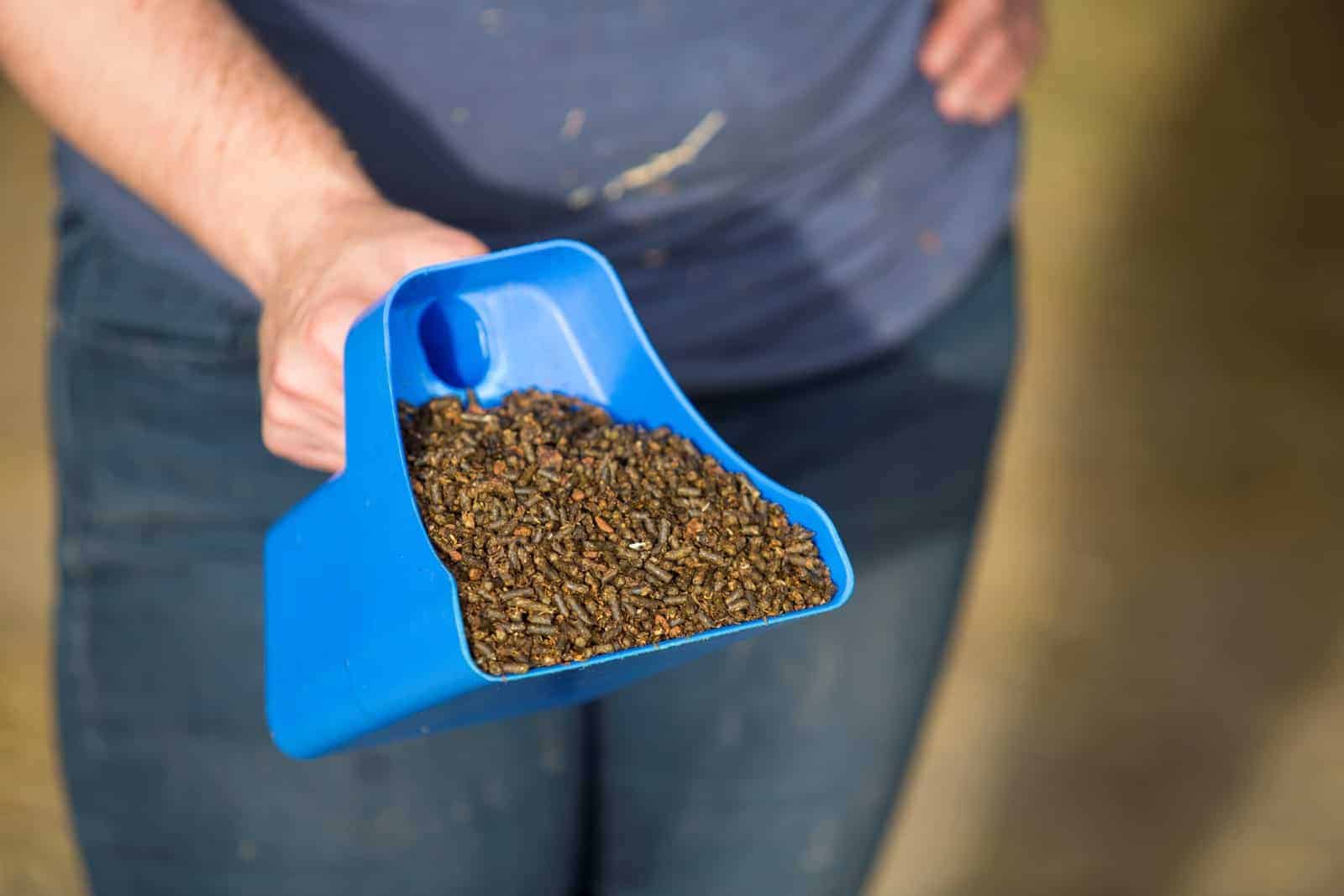Feeding the Athletic PPID Horse
- Posted by Clair Thunes, PhD

—Via e-mail
A.Every fall I hear of one or two horses that either get laminitis or founder due to previously undiagnosed and/or uncontrolled PPID, which is a heart-breaking situation. So, kudos to you for acknowledging the early signs and taking appropriate action. This is a condition that’s common in horses in their late-teen years (and sometimes earlier). It cannot be cured but can be managed with the medication Prascend, which helps slow progression.
Don’t Overlook Insulin Resistance
One of the big concerns with PPID is that overtime insulin resistance (IR) might develop, which is characterized by baseline hyperinsulinemia and/or having an excessive insulin response to an oral glucose challenge. Not all horses with PPID will develop IR, but having IR is a risk factor for laminitis, so it is vital that PPID horses have their baseline insulin levels monitored over time.
I’m not sure whether your vet also tested your horse for IR as well as PPID, and if you know your horse is already IR or not. Because we don’t know which PPID horses will develop IR, veterinarians and nutritionists generally recommended feeding all PPID horses be fed as though they are already IR. If your horse isn’t yet IR then you have a little more wiggle room with the diet, but it makes sense to try to reduce dietary starch and sugar, regardless.
Starch and simple sugars result in a rise in circulating insulin. Insulin’s job is to stimulate cells to take up glucose, thus, lowering levels of glucose circulating in the bloodstream. In IR horses, tissues inadequately respond to the circulating insulin. Initially the pancreas responds by secreting more insulin and reducing removal of insulin, which causes hyperinsulinemia (high circulating insulin). This is known as “compensated IR.” In people “uncompensated IR” also occurs where the pancreas becomes exhausted and fails to produce enough insulin to adequately reduce blood glucose levels; in this case, glucose control is poor and type II diabetes results. Uncompensated IR is rare in horses.
Horses and ponies with IR might have normal resting insulin levels but unusually high insulin in response to being fed glucose. Or they might have high resting insulin even when not given glucose. In people sustained hyperinsulinemia has been linked to vascular dysfunction, and laminitis is an example of vascular dysfunction in the horse.
The goal when managing PPID horses is to reduce risk of developing IR or to manage the IR in cases in which it already exists, thus reducing laminitis risk. Both are achieved by lowering starch and sugar intake. The diet for PPID horses with or without IR, as for all horses, should be forage-based. While we often rush to remove the concentrate portion of these horses’ diets (and concentrates should be reduced or removed in the case of IR), it’s important to remember that when the majority of the diet is forage, the forage might, in fact, provide the majority of dietary starch and sugar.
Therefore, try to find a source of hay that has low to moderate non-structural carbohydrate (NSC), ideally with less than 10% NSC. Soaked untested hay in cold water for an hour to remove about 30% of the sugar. This might not reduce the NSC to below 10% in very high sugar hays, but the hay will have less sugar than if it wasn’t soaked.
Not All Performance Feeds are High NSCs
Check the performance feed you’re using and find out its NSC content. While historically performance feeds were high in NSC due to their grain content, some current performance feeds are actually quite low and have NSC contents in the 10-12% range, making them appropriate for horses with PPID and/or IR.
Many such feeds have terms such as “low starch” in their name, but take these statements with caution: They don’t necessarily mean the feed is low enough for horses with metabolic issues. If your feed of choice doesn’t readily share its NSC content on the label or product website, reach out to a representative from the company to find out.
Senior Feed is an Option
Some senior feeds are also a good choice for PPID horses. However, do your homework, as not all are appropriate due to too high NSC content. The benefit of senior feeds is that they often have slightly higher crude protein levels and more readily digestible ingredients as senior horses sometimes have reduced absorption of protein and some key minerals. As horses with PPID might struggle to maintain lean muscle mass the higher protein level and easier digestibility might be beneficial.
Which ever feed you settle on, make sure that you are following the feeding directions to ensure that nutrient requirements are being met. If you don’t need to feed as much as recommended to maintain condition, consider adding a small amount of a low-NSC ration balancer to fill any gaps in key nutrients.
Pasture and PPID
As to pasture access, I think this comes down to the individual horse and owner. I have personally managed a horse with PPID on pasture and he never got laminitis and lived happily to age 29. I know other horses managed similarly without issue. But this takes a lot of very careful management, astute observation, and vigilance. I also know horses with PPID and IR that cannot handle access to pasture and have developed sore feet with low- to moderate-grade laminitis. Whether a PPID horse can handle pasture might depend on whether he also has IR.
If your horse is stable, does not show any signs of laminitis, has no laminitis history, and you are monitoring insulin and willing to educate yourself about when it is and is not appropriate for your horse to be on pasture, then it might be ok to continue with pasture access. I would recommend discussing this with your veterinarian, because he or she should have a better sense of your horse’s risk factors. Your veterinarian might be okay with your horse being on pasture at certain times of year or times of day, but he or she might not recommend it at all.
Take-Home Message
With careful management including regular blood work to monitor metabolic parameters, there is no reason why you and your horse should not continue to enjoy many more happy years together enjoying your sport of choice.

Written by:
Clair Thunes, PhD
Related Articles
Stay on top of the most recent Horse Health news with













One Response
I enjoyed your concise recommendations on PPID and Insulin Resistance (IR) in the performance horse as we are now seeing more and more older PPID horses in competition. And in fact, the USEF drug rules now allow Prascend in competition as long as you report it on the appropriate forms. One thing I hope that you can address in the future….the terminology of Insulin Resistance versus Insulin Dysfunction. The latter term has become more preferred (as we have also replaced Cushings with PPID). As we learn more about the elevated insulin levels we see in these horses and as diagnostics used in research studies have become more sophisticated, we have come to realize that many of these horses that have elevated insulin levels do not demonstrate insulin resistance. Some studies have suggested that these horses actually have an increased insulin response to meals possibly associated with excessive incretin levels or increased incretin sensitivity. Their insulin sensitivity at the cellular or organ level may in fact be normal. As we learn more about this population of horses with hyperinsulinemia, dietary management and therapeutic modalities may evolve differently than our current recommendations. So I would like to see more use of the term Insulin Dysregulation as it is more encompassing and also makes the literature more consistent. I would also like to suggest to you that decompensated insulin resistance/dysfunction may be more common than we recognize as blood glucoses are not monitored as frequently as insulins over the long haul. As we learn to manage these PPID/ID horses and their lives extend for several years after diagnosis, I have found, that if you do monitor glucose over time, that some do evolve from the compensated to decompensated ID form , truly developing Type 2 Diabetes. Our knowledge is ever changing…..
Thank you,
Karen J.Wolfsheimer, DVM, Ph.D., Dipl.ACVIM